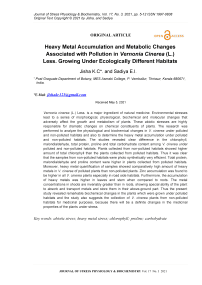Heavy Metal Accumulation and Metabolic Changes Associated with Pollution in Vernonia Cinerea (L.) Less. Growing Under Ecologically Different Habitats
Автор: Jisha K.C., Sadiya E.I.
Журнал: Журнал стресс-физиологии и биохимии @jspb
Статья в выпуске: 3 т.17, 2021 года.
Бесплатный доступ
Vernonia cinerea (L.) Less. is a major ingredient of natural medicine. Environmental stresses lead to a series of morphological, physiological, biochemical and molecular changes that adversely affect the growth and metabolism of plants. These abiotic stresses are highly responsible for dramatic changes on chemical constituents of plants. The research was performed to analyze the physiological and biochemical changes in V. cinerea under polluted and non-polluted habitats and also to determine the heavy metal accumulation under polluted and non-polluted habitats. The studies revealed clear difference in the chlorophyll, malondialdehyde, total protein, proline and total carbohydrate content among V. cinerea under polluted and non-polluted habitats. Plants collected from non-polluted habitats showed higher amount of total chlorophyll than the plants collected from polluted habitats. Thus it was clear that the samples from non-polluted habitats were photo synthetically very efficient. Total protein, malondialdehyde and proline content were higher in plants collected from polluted habitats. Moreover, heavy metal quantification of samples showed comparatively high amount of heavy metals in V. cinerea of polluted plants than non-polluted plants. Zinc accumulation was found to be higher in all V. cinerea plants especially in road side habitats. Furthermore, the accumulation of heavy metals was higher in leaves and stem when compared to roots. The metal concentrations in shoots are invariably greater than in roots, showing special ability of the plant to absorb and transport metals and store them in their above-ground part. Thus the present study revealed remarkable biochemical changes in the plants which were grown under polluted habitats and the study also suggests the collection of V. cinerea plants from non-polluted habitats for medicinal purposes, because there will be a definite changes in the medicinal properties of the plants under stress.
Abiotic stress, heavy metal stress, chlorophyll, proline, carbohydrate
Короткий адрес: https://sciup.org/143173897
IDR: 143173897
Текст научной статьи Heavy Metal Accumulation and Metabolic Changes Associated with Pollution in Vernonia Cinerea (L.) Less. Growing Under Ecologically Different Habitats
Plants are grown under different habitat. So they have to tolerate any change in environmental conditions. Under normal conditions, plants can continue with their homeostasis of normal metabolism. But any change in surrounding that cause adverse effect on physiological metabolism may disrupt the homeostasis of plant. There are a number of biotic and abiotic stresses in nature; of these, heavy metal stress is an important one in the current scenario of industrial civilization.
Vernonia cinerea (L.) Less. is a well known medicinal plant which belongs to the family Asteraceae. It is a cosmopolitan plant with erect, slender, rarely branching annual herb. Whole part of the plant used for medicinal purposes such as diuretic, antispasmodic, alexipharmic and anthelmintic. As far as medicinal plants were concerned, it should be careful that they should not be collected from the polluted habitats. Because these polluted habitats definitely affect their metabolic activity and also interfere with their medicinal property. Moreover the phytoremediation capacity of medicinal plants is not recommended especially when they are used in drug designing.
The present investigation deals with the comparison of various biochemical parameters and quantification of heavy metals [Zinc (Zn), Nickel (Ni), Lead (Pb) and Cadmium (Cd)] in the most common medicinal plant V. cinerea under non-polluted and polluted habitats.
MATERIALS AND METHODS
The present work was carried out with Vernonia cinerea (L.) Less. and the plants were collected from natural habitats, road side and canal side. The first one are considered relatively non polluted and later two are considered as polluted. For further reference, plants growing on the roadside of NH-17 are referred “plants (GOR)”, plants growing in the non-polluted area are referred as “plants (GON)” and those plants collected from polluted water side referred as ‘‘plants (GOW)”.
Plants were uprooted, kept in a polythene bag and brought to the laboratory for the uniformity of experiments, 5th leaf from the tip was selected from each plant and from each habitat, three samples were collected and each of them mixed separately. Plants were washed thoroughly in running tap water and the water was blotted off with a blotting paper. The experiments were performed without any delay. All the experiments were repeated three times.
The physiological parameters like dry weight, dry weight percentage and moisture content percentage of samples were determined. Samples (leaves) were weighed using electronic balance. For fresh weight and dry weight measurements, the plants were blotted and wrapped separately in pre-weighed labelled aluminium foils. Fresh weight of the samples was determined by weighing them immediately after wrapping. For dry weight measurements the samples were kept in a hot air oven at 100 0 C for one hour followed by at 60 0 C for overnight. After 48 h, the samples were transferred to a desiccator, allowed to cool and then weighed. The samples were reweighed as described above at regular intervals (24h), until the weights became constant. The dry weight percentage was calculated by using the following formula:
Dry weight
Dry weight percentage = x 100
' Fresh weight
Moisture content percentage was calculated by using the following formula
. Fresh weight - Dry weight
Moisture content percentage = — , ' x J UO
Fresh weight
Estimation of chlorophyll and carotenoids were done according to the method of Arnon (1949). The total carbohydrate content was estimated according to Dubois et al . (1956) and total protein content of the plant material was estimated using Folin–Ciocatteau reagent as per the method of Lowry et al . (1951). Proline content was estimated according to the method of Bates et al. (1973) and the MDA content in the samples was done according to Heath and Packer (1968).
For the heavy metal quantification, different plant parts root, stem and leaf tissues of these plants and soil around them were sampled and were dried at 60oC in a hot air oven. Known weight of the dried sample were digested by refluxing in 10:4 ratio of Nitric acid and perchloric acid until the solution become colourless using Kjeldahl’s flask heated in a sand bath. Then the digest was transferred to a standard flask and volume was made up to 50 ml and kept in screw capped containers. Atomic absorption spectrophotometer (ICPOES Optima 8000) available at College of Horticulture, KAU, Mannuthy, Thrissur was used for the estimation of heavy metals present in the digested samples.
RESULTS
Vernonia cinerea plants were collected from polluted and non-polluted habitat showed clear variation in their physiological and biochemical attributes such as chlorophyll, carbohydrate, MDA, proline and protein content. The chlorophyll and carbohydrate content reduced under stress conditions and the amount of protein, proline and MDA is higher under stress conditions.
Dry Weight Percentage And Moisture Percentage.
In the present study, dry weight percentage and moisture content percentage were varied in nonpolluted and polluted samples. Dry weight percentage was found to decreased with increase in the rate of pollution (Table 1). Moisture percentage was increased with increased stress conditions.
Chlorophyll and Carotenoid Content
Plants collected from canal side (GOW) showed decreased amount of total chlorophyll content than other two habitats. But in the case of road side sample (GOR), slight increases in chlorophyll content than plant from non-polluted (GON) habitat were observed. The total chlorophyll content in canal side was 1293.3µg/g dw and in road side it was 1700.5µg/g dw. In non-polluted area the amount of total chlorophyll content was 1428.04µg/g dw (Fig.1a).
The V.cinerea plant collected from non-polluted habitat showed lesser amount of carotenoid (32.72µg/g dw), where it was higher in road side (188.7µg/g dw) and canal side (206.55µg/g dw) samples respectively (Fig.1b). So it was clearly understood in the present study that under stress condition the amount of carotenoid content is increased in V. cinerea plants.
Total Carbohydrate and Total Protein Contents
The total carbohydrate content was decreased under polluted conditions. The amount of carbohydrate in plant grown near canal side was 134.45µg/g dw. Where it was 206.5µg/g dw and 225.7µg/g dw in non-polluted and road side samples respectively (Fig. 2a). The plant under non-polluted habitat showed lower amount of protein compared to plants of polluted area. Plants from road side and canal side recorded 56 and 62.8µg/g dw of protein content respectively, but in plants of nonpolluted area it was 34.5µg/g dw (Fig. 2b).
Proline and MDA Content
Under stressed conditions the amount of proline clearly increased in the plants collected from polluted habitats when compared with the plants from nonpolluted conditions. The higher amount of proline found in road side sample. But only slight variation was found in roadside and canal side samples (68.54 and 59.7µg/g dw respectively). Plants from non- polluted area showed less amount of proline (40.91µg/g dw) (Fig. 3a).
The plant under non-polluted habitat showed comparatively lower amount of MDA compared to plants of polluted area. Plants from road side and canal side recorded 24.4 and 26.6µmol/g dw of MDA content, but in plants of non-polluted area it was 17.7µmol/g dw (Fig. 3b).
Heavy Metal Quantification
Quantification of heavy metal showed high Zn content in all samples than Ni, Pd and Cd. Zinc metal is higher in road side samples, especially in roots and leaves. The leaf sample showed higher amount of Zn accumulation (967µg/g dw). The Zn accumulation in the sample near the polluted water body showed lower amount of Zn than road side sample (Fig. 4a). In the case of Ni, the accumulation was higher in road side and canal side samples. Nearly 1.5 µg/g dw accumulation can be seen in all the samples. Nickel accumulation is found higher in roots and leaves rather than stem (Fig.4b). Lead accumulation was found to be higher in the roadside leaf sample. Roots of both roadside and canal side plants showed lower amount of Pd was when compared to that of leaves. Lead accumulation is higher in leaf samples than other two parts in three conditions (Fig. 4c). Cd also found in higher in road side sample especially in leaves (Fig. 4d).

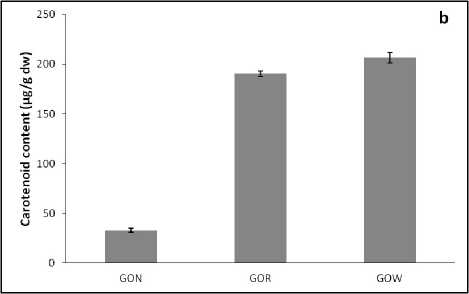
Figure 1. ( a ) Total chlorophyll content and ( b ) Carotenoid content in the leaves of V. cinerea grown under three habitat (non-polluted-GON, Road side-GOR and canal side-GOW). The vertical bars represent SE of the mean value of recordings from three independent experiments each with a minimum of three replicates.

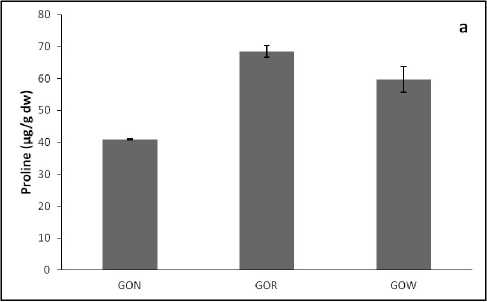
Figure 3. ( a ) Proline and ( b ) MDA content in the leaves of V. cinerea grown under three habitat (non-polluted-GON Road side-GOR and canal side-GOW). The vertical bars represent SE of the mean value of recordings from three independent experiments each with a minimum of three replicates.
Figure 2. ( a ) Total carbohydrate content and ( b ) Total protein content in the leaves of V. cinerea grown under three habitat (non-polluted-GON, Road side-GOR and canal side-GOW). The vertical bars represent SE of the mean value of recordings from three independent experiments each with a minimum of three replicates.

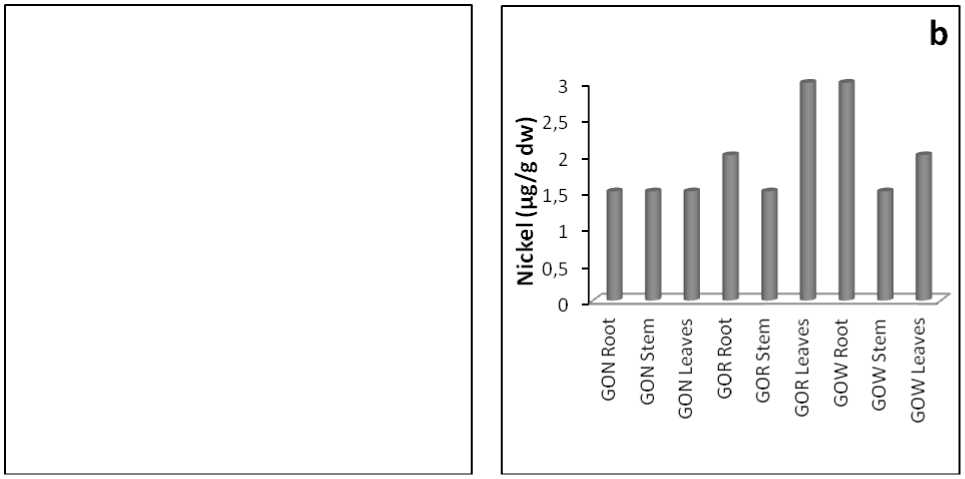
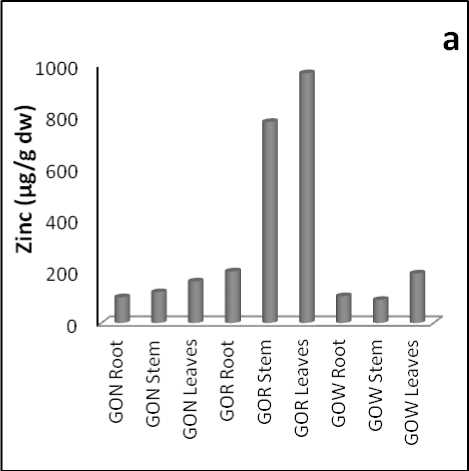
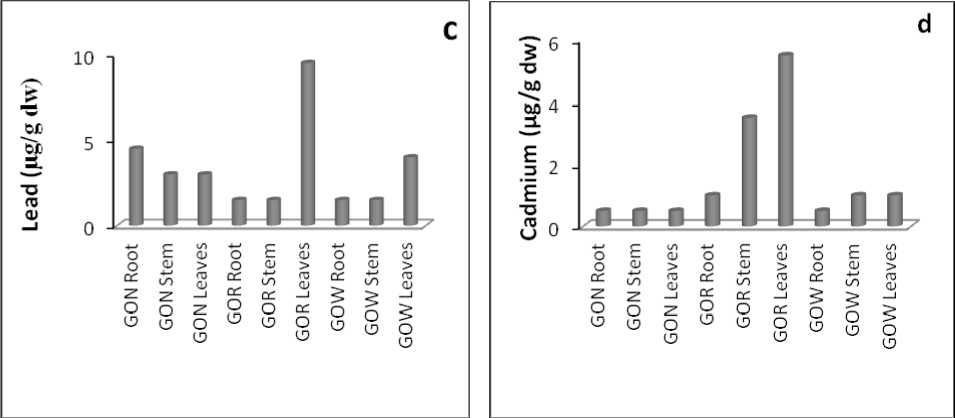
Figure 4. ( a ) Zinc, (b) Nickel, (c) Lead and (d) Cadmium accumulation in the roots, leaves and stems of V. cinerea grown under three habitats (non-polluted-GON, Road side-GOR and canal side-GOW).
Table 1. Dry weight percentage and moisture percentage in V. cinerea under polluted and non-polluted habitats.
|
Plants |
Dry weight % /mg |
Moisture %/ mg |
|
|
GON |
23.07 |
76.93 |
|
|
GOR |
20.83 |
79.17 |
|
|
GOW |
20 |
80 |
DISCUSSION
In the present study, various physiological and biochemical parameters were analysed in Vernonia cinerea plants growing under polluted and non-polluted habitats. From the results, it was found that V. cinerea plants growing under non-polluted habitat showed more dry weight percentage. Moisture percentage is higher in plants of polluted habitat. The photosynthetic pigments and carbohydrate decreased under stress condition. The most common stress indicating compounds protein, proline and MDA was higher under stressed condition.
Under stressed conditions, it was already reported that growth attributes like fresh weight, dry weight decreases in plants when compared with the plants which were grown under unstressed condition. It may be due to increased utilization of metabolites for competing with stress rather than for growth and reproduction of plants. The fresh weight reduced under drought condition in Triticum aestivum and Pennisetum glaucum (Khalid 2006). was This may be due to suppression of cell expansion and cell growth which in turn attributed to low pressure (Sankar et al . 2007)
The chlorophyll content of V. cinerea in stressed condition of road side and canal side showed reduced amount than controlled habitat, because the chloroplast is most sensitive to environmental stresses. Chlorophylls are important to maintain photosynthetic activity in plant (Nageswara et al. 2001). Thus changes in the environmental conditions certainly caused decline in the quantity of chlorophylls. Under drought conditions plant will have low stomatal index as per that photosynthetic assimilation will decreases due to lower rate of CO 2 diffusion (Boyer 1970). The decrease in chlorophyll may be due to the formation of proteolytic enzymes such as chlorophyllase, which is responsible for the chlorophyll degradation as well as damaging to the photosynthetic apparatus (Dogan 2011).
In the present study the amount of carotenoid content increased with increased stress condition. So we can assume that carotenoid has role in stress tolerant mechanism. They are involved in oxidative stress tolerance mechanisms. During oxidative damage carotenoids release excess excitation energy as heat or by scavenging ROS and suppressing lipid peroxidation. Studies in Cicer arietinum L (Talebi et al . 2013) revealed higher carotenoid content in drought tolerant genotypes.
In the case of carbohydrate content more decrease in its amount found in stressed condition of plant from canal side. From road side and controlled habitats only slight variation was shown in the data. The carbohydrate content of road side sample is just lesser than nonstressed sample value. But the canal side samples showed declined level of carbohydrate than other two Samples. When compare the carbohydrate with the chlorophyll content reveals that both are decreased in canal side sample and almost similar result found in road side and control. Different abiotic stresses affect on plant causes alteration in photosynthesis and carbon partitioning are common (Gill et al. 2003). Sugar signaling pathways interact with stress pathway into complex network to modulate metabolic plant responses (Tran et al. 2007). High light irradiance, heavy metals nutrient shortage and ozone decreases sugar concentration. These changes can be related with distruption of chloroplast structure and blocking of chloroplast electronic transport as in high UV irradiance, ozone and heavy metals stresses (Day 2002; Hilal et al. 2004).
Amount of total protein under stress condition is increased in this study. Even though some proteins are denatured under stress condition and reduction of metabolic activities occur such as photosynthetic inhibition, but amount of total protein is increased under stress condition in the present study. So it was clear that as increasing the stress conditions some specific proteins are produced. Heat shock proteins are one of the main stress tolerant proteins (Wang et al . 2003).
The quantification of proline content in this study indicated that proline is another stress indicating compound. Amount of proline is higher in polluted habitat of road side and canal side. Increase of proline under stress condition is because it is an imino acid which act as osmolytes during osmotic stress (Ashraf and Foolad 2007). Reports based on function of proline under stress condition can compare with these results. Proline is reported to function as stabilization of proteins, membranes and sub-cellular structures, free radical scavenging (Joshi et al . 2011). The accumulation of proline content under stress condition can correlated with other studies (Posmyk and Janas 2007).
Quantification of MDA content in the samples revealed slight increase in stress conditions. MDA is already known as a stress indicator. So in the present study also, increase in MDA denotes the increased stress for the plants. Under stressed conditions, plant cell undergoes membrane damage and leakage may be due to the action of free radicals. These ROS causes lipid peroxidation of biomembrane which leads to the production of MDA (Moussa and Aziz 2008). So MDA can consider as important sign of membrane system injury (Cunhua et al. 2010). Water stress increases the MDA content in Zea mays (Anjum et al. 2012). More over Cicer arietinum under drought stress showed higher MDA content than plant grown under controlled condition (Mohammadi et al. 2011).
Zinc accumulation was found to be higher in all samples especially in road side. From this data we can find that accumulation of heavy metals was higher in leaves and stem. The metal concentrations in shoots are invariably greater than in roots, showing special ability of the plant to absorb and transport metals and store them in their above-ground part.
CONCLUSION
In this present study, Vernonia cinerea (L.) Less. was preferred as an experimental plant because of its importance in natural medicine. Abiotic stress factors are the main limitation to plant growth and yield in agriculture. Abiotic stress leads to a series of morphological, physiological, biochemical and molecular changes that adversely affect plant growth and productivity. These abiotic stresses are highly responsible for dramatic changes on chemical constituents of plants. In this present study, it was understood that the V. cinerea collected from polluted areas showed variations in various physiological and biochemical attributes when compared with the samples collected from non-polluted areas.
The analysis showed clear difference in the chlorophyll, MDA, protein, proline and carbohydrate content among the samples of GON, GOR and GOW. In the case of V. cinerea collected from GON showed higher amount of total chlorophyll than the other two samples of GOR and GOW. At the same time protein, MDA and proline content were lower than that of other two samples.
So it was clear that the samples from non-polluted habitats were photo synthetically very efficient. Moreover, the lower amount of protein, prolineandMDA clearly indicated that the samples collected from GON were not stressed. The V. cinerea collected from GOR and GOW were under stressed. Besides this heavy metal quantification of samples showed comparatively high amount of heavy metals in V. cinerea of polluted plants than non-polluted plants.
Thus the present study revealed remarkable biochemical changes in the plants which were grown under polluted habitats and the study also suggests the collection of V. cinerea plants from non-polluted habitats for medicinal purposes, because there will be a definite changes in the medicinal properties of the plants under stress.
ACKNOWLEDGEMENT
We acknowledge Kerala State Council for Science, Technology and Environment (KSCSTE) for the financial support for the conduction of this research work.
CONFLICTS OF INTEREST
All authors have declared that they do not have any conflict of interest for publishing this research.
Список литературы Heavy Metal Accumulation and Metabolic Changes Associated with Pollution in Vernonia Cinerea (L.) Less. Growing Under Ecologically Different Habitats
- Anjum, S.A., Xie, X., Wan, L., et al. (2012) Morphological, physiological and biochemical responses of plant to drought stress. Afr. J. Agr. Res., 6: 2026-2032.
- Arnon, D.I. (1949) Copper enzymes in isolated chloroplast polyphenoloxidase in Beta vulgaris. Plant Physiol., 24: 1-5.
- Ashraf, M. and Foolad, M.R. (2007) Roles of Glycine betaine and Proline in improving plant abiotic stress resistance. Envir. Exp. Bot., 59: 206-216.
- Bates, L.S, Waldren, R.P. and Teare, I.D. (1973) Rapid determination of free proline for water stress studies. Plant Soil, 39: 205-208.
- Boyer, J.S. (1970) Leaf enlargement and metabolic rates in corn, soybean and sunflower at various leaf water potentials. Plant Physiol., 46: 233-235.
- Cunhua, S., Wei, D., Xiangling, C., Xinna, X., Yahong, Z., Dong, S. and Jianjie, S. (2010) The effect of drought stress on the activity of acid phosphatase and its protective enzymes in pigweed leaves. Afr. J. Biotechnol., 9: 825-833.
- Day, T.A. and Naele, P.J. (2002) Effects of UV_B radiation on terrestrial and aquatic primary producers. Annu. Rev. Ecol. System., 33: 371-396.
- Dogan, M., Tipirdamaz, R. and Demir, Y. (2010) Salt resistance of tomato species grown in sand culture. Plant Soil Environ, 56: 499-507.
- Dubois, M., Gilles, K.A., Rebers, P.A., Hmilton, J.K. and Smith, F. (1956) Colorimetric method for determination of sugar and related substances. Anal. Chem., 26: 350-356.
- Gill, P.K., Sharma, A.D., Sing, P. and Bhullar, S.S. (2003) Changes in germination, growth and soluble sugar contents of Sorghum bicolor (L.). Moench seeds under various abiotic stresses. Plant Growth Regul., 40: 157-162.
- Heath, R. and Packer, L. (1968) Photoperoxidation in isolated chloropkast. I Kinetics and stochiometry of fatty acid peroxidation. Pak. J. Bot., 125: 189-198.
- Hilal, M., Parrado, M.F., Rosa, M., Gallardo, M. and Massa, E.D. (2004) Epidermal lignin deposition in quinoa cotyledons in response to UV-B radiation. Photochem. Photobio., 79: 205-210.
- Joshi, M.K., Desai, T.S. and Mohanty, P. (2011) Temperature dependent alteration in the pattern of photochemical and non-photochemical quenching and associated changes in the photosystem II conditions of the leaves. Plant Cell Physiol., 36: 1221-1227.
- Khalid, M.J., Akhtar, M., Mahmood, H. and Arshad, M. (2006) Effect of substrate-dependent microbial ethylene production on plant growth. Microbiol., 75: 231–236.
- Lowry, O.H., Rosenbrough, N.J., Farr, A.L. and Randall, R.J. (1951) Protein measurement with Folinhenol reagent. J. Biol. Chem., 193: 265–275.
- Mohammadi, A., Habibi, D., Rihami, M. and Mafakheri, S. (2011) Effect of drought stress on antioxidant enzymes activity of some Chickpea cultivars. Am-Eura. J. Agri. Environ. Sci., 11: 782-785.
- Moussa, H. and Abdel-Aziz, S.M. (2008) comparative response Maize genotypes to water stress. Aust. J. crop Sci., 1: 31-36.
- Nageswara, R.R.C., Talwar, H.S. and Wright, G.C. (2001) Rapid assessment of specific leaf area and leaf nitrogen in peanut using chlorophyll meter. J. Agron. Crop Sci., 189: 175-182.
- Posmyk, M.M. and Janas, K.M. (2007) Effects of seed hydropriming in precence of exogenous proline on chilling injury limitation of Vigna radiata L. seedlings. Acta Physiol. Plant. 17: 29-509.
- Sankar, B., Jaleel, C.A., Manivannan, P., Kishorekumar, A., Somasundaram, R. and Panneerselvam, R. (2007) Effect of paclobutrazol on water stress amelioration through antioxidant and free radical scavenging enzymes in Arachis hypogaea L. Colloids Surf. B: Biointerfaces, 60: 229-235.
- Talebi, R., Ensafi, M.H., Baghbani, B., Karami, E. and Mohammadi, K.H. (2013) Physiological responses of chickpea (Cicer arietinum) genotypes to drought stress. Env. Exp. Biol., 11:9-15.
- Tran, L.S., Nakashima, K., Shinozaki, K., Yamaguchi, K. and Shinozaki (2007) Plant gene networks in osmotic stress response: from gene to regulatory networks. Methods Enzymol., 428: 109-128.
- Wang, W., Vinocur, B. and Altman, A. (2003) Plant responses to drought, salinity and extreme temperatures: Towards genetic engineering for stress tolerance. Planta ,218: 1–14.

